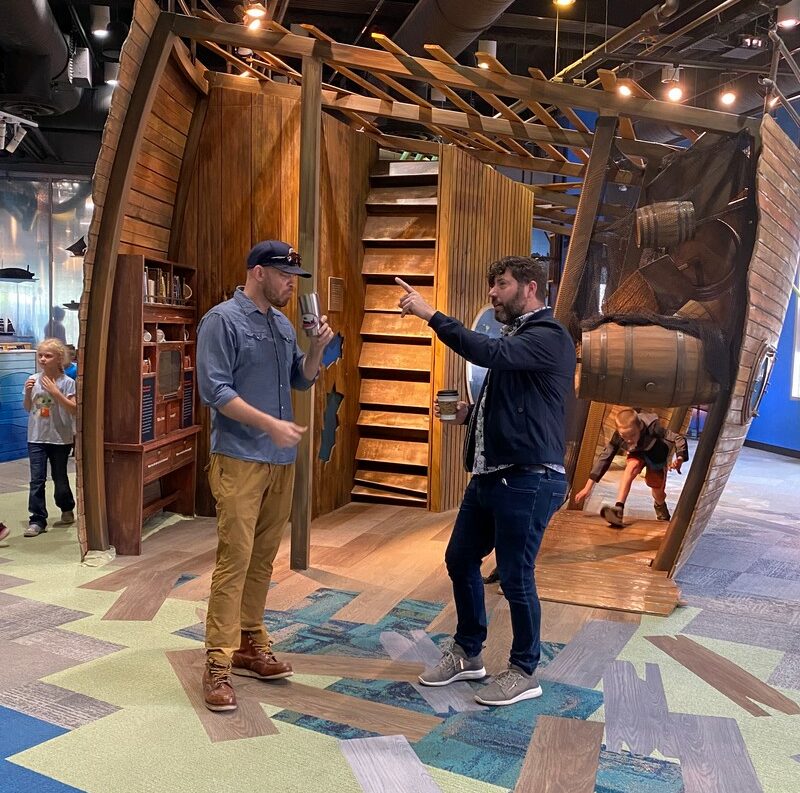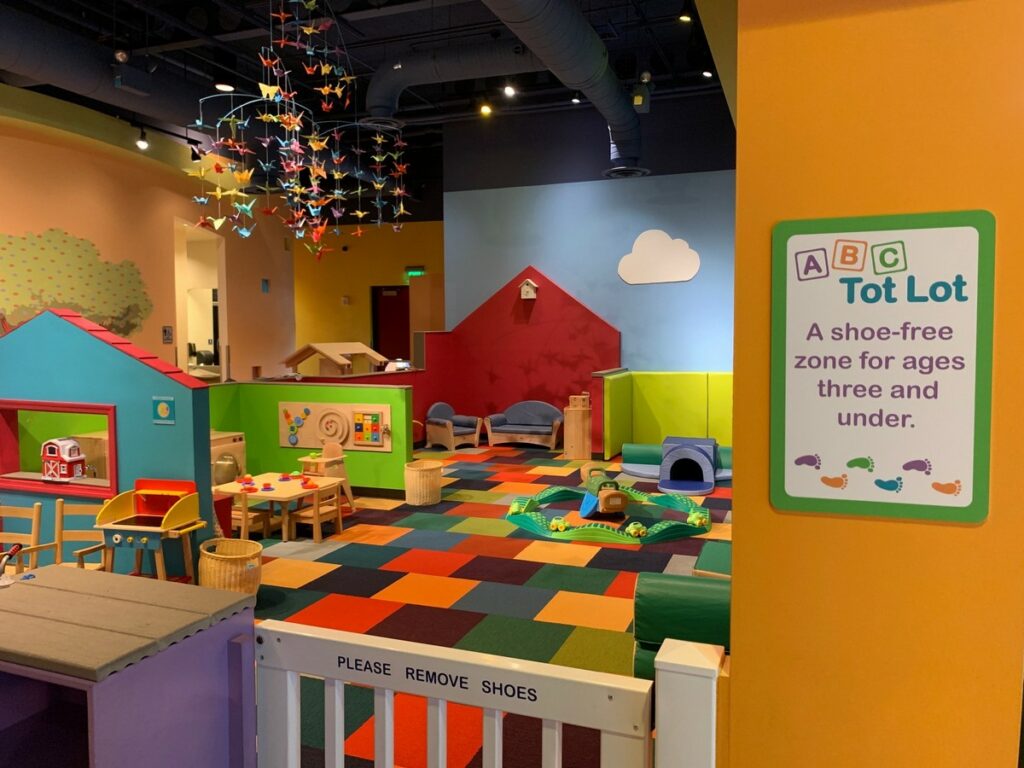10 Lessons Learned Creating Children’s Museum Exhibits
We’ve learned a few things through our work developing museum exhibits over more years than we’d like to admit. Here are a few lessons learned to help you avoid some painful mistakes.
- Buying-consumer grade goods usually spells trouble.
We’ve all done it. We (or a board member) saw something that looked really incredible at IKEA, Crate & Barrel, or Amazon (ahem… Melissa & Doug) and thought, “This could be perfect for our new exhibit.” Inevitably, days or weeks after opening, it’s already broken or showing wear. You really do get what you pay for. The truth is that creating experiences that are durable enough for children’s museum audiences isn’t easy. Kids will climb, jump on, drop, and abuse exhibits in ways you probably never imagined.
Our Advice: Try to avoid elements that look pretty, but aren’t designed for commercial use. If you do buy something off-the-shelf, try to make it more durable by using glue on wood joints, adding brackets, scotchguarding fabric, adding a clear coat of paint, or any other means you can think of to make it more durable to stretch your investment before it hits the exhibit floor.
- Everything needs to be cleaned.
One good thing that came out of our experience with Covid, is that we got much better at approaching and formalizing how we clean our museums. Every exhibit should have a cleaning plan from the very start. Material choices for exhibits should consider how easy something is to keep clean and looking fresh. Anyone who’s worked in a children’s museum will tell you not to paint your exhibits white or yellow because you’ll never be able to keep them looking clean.
Our Advice: For high-touch areas, choose hard surfaces that can easily be sanitized. Have a plan for removing and cleaning “mouthed” toys and have multiple sets of loose parts so that they can be rotated out and cleaned regularly. If you are building a new museum, be sure to include a dishwasher as well as a washer and dryer. Fabric is typically a no-no, unless you plan to wash and replace it often. Involve your facility and cleaning staff in the exhibit development process at certain milestones for their input. They will be grateful to participate—and your exhibit will be more sustainable in the long run.
- Lots of loose pieces means lots of cleanup.
Nearly every children’s museum has a grocery store—and for good reason. We’re not just providing our visitors with a playground, but giving children an opportunity to model and process behavior they’ve observed in the world around them. The grocery store, kitchen, and other exhibit themes provide a perfect setting for this type of learning and pretend play. Creating these spaces means lots of fake food, dishes, custom props—hundreds of loose parts that end up on the floor or travel throughout the museum, seldom staying where they belong. We know it’s part of the experience, but it looks messy and takes a lot of time to reset.
Our Advice: Be intentional about how many loose parts you include in an exhibit. Everything should have a purpose. How many props are needed for a fulfilling experience? Perhaps some items can be replaced with a tactile model that is fixed in place. Give visitors the tools to know where things are supposed to go so that they can be part of the clean up. Graphics lining the back of shelves or the bottom of bins can help indicate what is supposed to go in that spot and make the exhibit look more full with fewer pieces.

- Play should have a purpose.
We love to see kids playing in our museums because we know that they are learning so much through each interaction—but what type of play are we setting them up for? Pretend play is wonderful, but we shouldn’t just stop there.
Our Advice: Each experience can be intentionally designed to encourage skill development that is targeted for your target age group audience—and scaffolded appropriately. Whether it’s dexterity, executive function skills, critical thinking, socioemotional learning, or communication skills, how can you encourage and facilitate these learning opportunities? Since the learning needs of visitors vary greatly by age and ability, consider how you can create experiences where different visitors can have meaningful but different learning outcomes. You get bonus points awarded if kids have a chance to problem solve together with other children or their caregivers.

- How it looks is just as important as how it works.
Our museums can start to look dated even faster than our living rooms at home. It’s important to our bottom line that visitors feel comfortable in our spaces and want to come back. Most museums can’t invest to update exhibits every five years (even though we tell ourselves we will), but we still need to work to keep galleries looking fresh and enticing.
Our Advice: Don’t underestimate the impact of a fresh coat of paint, updated graphics, and good lighting. We recommend that you have a plan to fully update one gallery or exhibit space each year. At the same time, try to give a simple refresh or facelift to a second space. The changes will show your visitors that you care about their experience and are excited to welcome them back to see what’s new at the museum.
John Shaw chatting with friend Mitch Boerner about recent gallery renovations at the Minnesota Children’s Museum.

- Create seasonal experiences, not seasonal décor.
When we see every retail store put up new holiday decorations, it’s tempting to think we should be doing the same thing. But is that why our guests plan a visit? With limited resources, we need to put our money into cosmetic updates that last—or better yet—experiences that visitors can’t have anywhere else.
Our Advice: Rather than putting up holiday decorations throughout the whole building where they may not be noticed or feel appropriate, why not create a seasonal experience in a designated area that you can recreate year after year? It’s okay to start small and build on the experience over time. These are the activities that build memories—and hopefully nostalgia when today’s visitors bring the next generation of visitors back to your museum.

- A touchscreen is not the experience your visitors need.
Screens have become so ubiquitous in our lives that we can’t avoid them. Even toddlers have access to TV, iPads, and games on a caregiver’s phone. The children’s museum is often a nice break from screens and the chance to do something hands-on and minds-on together.
Our Advice: Think long and hard before adding a touchscreen experience to your gallery. What is the purpose and takeaway—and is this the best way to design this experience? Please don’t use an iPad or iPhone app as an exhibit, unless it’s specifically designed for the purpose. Your visitors deserve an experience that they can’t get at home.

- There is power in the real.
Whether it’s an original artwork, an object of historic significance, or a scientific experiment conducted right in the gallery, museums have a unique opportunity to channel the power of real. As children’s museums, sometimes we are so focused on making exhibits padded for safety and designs that look more like they came out of a cartoon rather than from the natural world. Elements of the real world provide unique opportunities to spark imagination and curiosity that we can lean into.
Our Advice: Don’t be afraid to tap into this power of the real too. With careful thought and planning, you can display real art and specimens—and do live science experiments. There are also simpler forms of real that help your visitors understand and make sense of the world around them— exploring seed pods, shells, and other natural objects; using real versions of tools in our maker spaces; or an up-close encounter with a live animal—these are all great ways to make connections through your museum.
- Water tables are wonderful, but know what you are signing up for.
Water table exhibits are consistently popular with museum visitors. They provide open-ended play that can’t easily be replicated at home—at least not without creating a big mess. There’s a lot to appreciate about these exhibits, but they also require a lot of maintenance and operational planning.
Our Advice: Use a reputable vendor that specializes in this type of exhibit rather than trying to build it yourself or taking a chance with a vendor who is figuring it out for the first time. Not only do water exhibits have to be built to withstand rust, corrosion, and mold (just like outdoor exhibits), they also involve pumps and electrical elements that require regular maintenance. More importantly, maintaining proper water quality is critical to avoid spreading bacteria and illnesses. Make sure your staff have the time and know-how to take care of daily maintenance, cleaning, and monitoring of water chemistry to avoid this attraction becoming a distraction.
- Learn from others, but make it your own.
We love the community and sharing that comes with being part of the children’s museum field. Whenever we travel, our team visits other museums and are inspired by their exhibits and energized to bring back new ideas for our own work. For us, we appreciate learning from others to deliver a better museum experience—gleaning what works, what should be avoided, and what resonates at other museums. Your museum shouldn’t look like every other children’s museum, but instead celebrate your unique location and community.
Our Advice: Your museum should fit the needs of your community and reflect what makes your organization special. Your museum is a product of your organization’s unique personality and borne of your team’s ideas and values, not just a collection of stuff. When you see a great exhibit at another museum, take note of what you like about it—rather than just trying to duplicate it. What does it do well and what could be improved upon? If you decide to create something similar, how can you make it different/better/unique to fit the needs of your museum? Embrace the talent of local artists, craftspeople, and your own team to give your museum a personality of its own–something your hometown can be proud of.

About the Author:
John Shaw began his museum career by accident after accepting an internship in Human Resources at the Center of Science and Industry (COSI) while finishing his degree in business administration. In the more than 20 years since this happy accident, he has worked in children’s museums and science centers leading teams in exhibit development, project management, fabrication, exhibit maintenance, traveling exhibits, and facility renovations. John enjoys the variety of tasks that come with creating experiences—from balancing spreadsheets and writing interactive exhibit narratives to learning about and testing new technologies.



